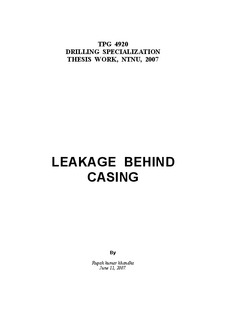| dc.description.abstract | Achieving zonal isolation by cementing annulus space between casing and well bore is an important job in many oil wells. Gas leakage in the annulus has been recognised as a major completion problem in the oil well. A successful cement job results in complete zonal isolation on a permanent basis. To achieve these goals, various factors such as well security, casing centralization, effective mud removal, and gas migration must be considered in the design. The design of the cement must be such that it prevents micro-annuli formation, stress cracking, corrosive fluid invasion, fluid migration, and annular gas pressure. However, permanent solutions to gas leakage has not emerged and gas leaks during and after the cement is set.
In this thesis work attempt has been made to deal the fluid leakage behind casing in two levels, firstly, revealed gas migration mechanism and, secondly, analytical modeling of cement sheath failure by internal and rising temperature. Several theories have been proposed regarding gas migration. In chaper 2 some probable physio-mechanical phenomena responsible for fluid migration in the cemented casing have been described. During cement setting and hardening gas migration is attributed to ineffective hydrostatic head, fluid loss during cementing, and the differential pressure occurrence due to the gelation. Micro annulus is attributed to the cement inability to form a good bond with the casing. Cyclic pressure and temperature variations during production also lead to the debonding or tensile failure or stress crushing of the cement causing gas migration. Gas leakage may occur years after production has ceased and well has been plugged and abandoned (P&A). Explanatory mechanism includes channeling, poor mud removal, shrinkage, and high cement permeability.
In chapter 3 efforts have been made to describe the case studies regarding zonal isolation. Case 1 describes the specialized cement design and placement procedures to mitigate casing vent flows (type: improve plan to avoid problem). Case 2 depicts a new cementing approach to improve and provide long term zonal isolation. Case 3 is related to the development of a methodology to evaluate the gas migration in cement slurries (type: predicting problem before it arises).
The stress in the cement is strongly connected with temperature and pressure, as well as lithology and in-situ stress. In chapter 4 an attempt has been made to quantify the cement failure as a function of down hole conditions and geometry and to define optimum mechanical properties to sustain the induced stresses. Analytical modeling has been done on the basis of plane strain in thin wall condition. Expressions for total stresses (hoop stress in casing, hoop stress in cement, and far field stress) are used to analyzed the cement integrity based on the case study well parameters of the Kristin Oil Field of Norway, Well R-3H (chapter 5). As this oil field is HTHP type, conventional cement is found not withstanding the stresses. In most of the situation tensile failure is the mode of failure, in some cases stress crushing and debonding. Improving the elasticity of cement or it’s flexural and tensile strength appeared to be an elegant solution to prevent cement failure (debonding, radial craking, and stress crushing). In addition, improvement can be made using high grade casing pipe (high Young’s modulus, low Poisson’s ratio). In reality a thick wall high grade (Q-125, SM-125) casing program has been selected in the Kristin Oil Field. The results of this study show the relevant dependency of stress principles with differential well temperature, pressure and field stress, Young’s modulus, thickness, and diameter of casing and cement sheath are also important. | nb_NO |
